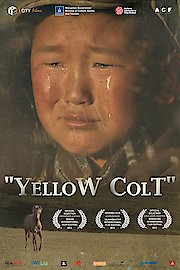-
Genres
-
CastB. NarankhuuS. Damdin
-
DirectorKhoroldorj Choijoovanchig
-
Release Date2013
-
Runtime1 hr 30 min
-
LanguageMongolian
-
IMDB Rating8.4 (44)

Yellow Colt is a poignant and visually captivating Mongolian film that takes audiences on a tender and heartwarming journey through the captivating landscapes of Mongolia. Released in 2013, this extraordinary coming-of-age tale is directed by renowned Mongolian filmmaker B. Narankhuu and stars S. Damdin in the pivotal role. Set against the backdrop of the vast Mongolian steppe, Yellow Colt tells the story of a young boy named Amra, played by S. Damdin, and his profound connection with an orphaned baby colt. Amra, a bright, imaginative, and curious child, lives in a nomadic family that raises livestock on the grasslands. When his family discovers an abandoned and wounded colt, Amra becomes enamored with the fragile animal's fight for survival, and he takes it upon himself to nurse the young colt back to health.
As the bond between Amra and the yellow colt grows stronger, the film beautifully explores themes of companionship, loyalty, and the resilience of the human spirit. The portrayal of the boy's relationship with the animal achieves a delicate balance, evoking a sense of wonder and enchantment while remaining grounded in the harsh reality of life on the Mongolian steppe.
Through mesmerizing cinematography, the film captures the breathtaking beauty of the Mongolian landscapes, showcasing rolling hills, endless grasslands, and rugged mountains. The vastness and serenity of the surroundings provide a perfect canvas for Amra's journey, emphasizing the harmony between humans and nature in a way that is deeply rooted in the nomadic culture of Mongolia.
Yellow Colt is not just a tale of a boy and his horse; it is also a contemplation on the cultural heritage and legacy passed down through generations. It provides a unique glimpse into the traditional nomadic lifestyle, where respect for animals and the land is fundamental. The film's attention to detail and authenticity in portraying the everyday life of a Mongolian family offer an immersive experience, depicting customs, rituals, and family dynamics in a way that transports viewers to another time and place.
Both S. Damdin's nuanced performance as Amra and the naturalistic portrayals by the supporting cast contribute to the film's immersive quality. The film beautifully captures the boy's transformation as he learns essential life lessons, grapples with loss and adversity, and finds solace, strength, and purpose through his connection with the colt. Damdin's portrayal is filled with genuine emotion, reflecting the resilience, innocence, and relentless spirit of a child discovering his place in the world.
The film's narrative is tenderly woven, balancing moments of joy, melancholy, and wonder in equal measure. The screenplay, penned by B. Narankhuu himself, elegantly incorporates traditional Mongolian storytelling techniques while infusing it with a universal charm that transcends cultural boundaries. The pacing, though deliberate, allows the audience to savor each moment and fully immerse themselves in Amra's journey.
The remarkable score heightens the emotional impact of the film, blending traditional Mongolian melodies with evocative compositions. The music serves as a harmonious companion to the stunning visuals, eliciting a wide range of emotions from elation to introspection.
Yellow Colt stands as a testament to the power of storytelling and the enduring bond between humans and animals. It celebrates the resilience and strength of individuals in the face of adversity, and it offers a glimpse into the timeless traditions and values of Mongolian culture.
In conclusion, Yellow Colt is a visually breathtaking and emotionally resonant film that takes audiences on a captivating journey through the Mongolian steppe. With its evocative storytelling, remarkable performances, and stunning cinematography, the film encapsulates the spirit of Mongolia and leaves viewers with a profound appreciation for the majesty of nature and the resilience of the human spirit.